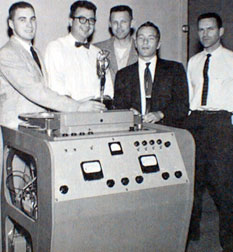|
Video
Recording > Introduction
|

Above: The first video recorder and
the guys who built it. Company executives
honestly thought that worldwide demand
for VCRs would never exceed about
30 per year. I think I have 30 in
my house alone! (Courtesy Ampex)
|
|
|
In the early days of television, there were no VCRs.
In fact, the only method available to record television
shows was to point a movie camera at the TV screen--not
exactly a good solution. (The name for this lame process
was "Kinescope").
Then,
in 1956, Ampex (an American company) invented the first
video recorder. It was bigger than a refridgerator and
cost hundreds of thousands of dollars. The tape was
a monstrous two inches wide and wrapped around massive
reels nearly the size and weight of an inflated car
tire.
We’ve
come a long way. Today, there are lots of different
types of videotapes out there, each with strengths and
weaknesses. We call these different systems "formats."
The format you know about is VHS; but there are many
others. It’s important that you understand the
most common production formats. Nothing brands you as
an amatuer more quickly than an ignorace of recording
formats.
Perhaps
I should back up a bit and say that when a CNN news
crew, for example, go out to shoot a story--their camcorder
does NOT use a VHS tape. It uses a different type of
tape (and VCR) that records at much higher quality level.
But that quality comes at a price--their camcorders
probably cost about $80,000.

|